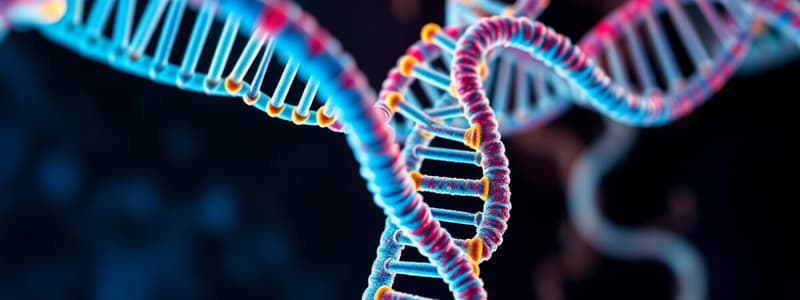Podcast
Questions and Answers
Match the following DNA components with their characteristics:
Match the following DNA components with their characteristics:
Adenine (A) = Pairs with Thymine (T) Guanine (G) = Pairs with Cytosine (C) Thymine (T) = Replaced by Uracil (U) in RNA Cytosine (C) = Forms hydrogen bonds with Guanine (G)
Match the following RNA types with their functions:
Match the following RNA types with their functions:
mRNA = Carries information from DNA to ribosomes rRNA = Structural component of ribosomes tRNA = Brings amino acids to ribosomes for protein synthesis snRNA = Involved in RNA splicing
Match the following statements with their relevance to DNA replication:
Match the following statements with their relevance to DNA replication:
DNA polymerase = Enzyme required for DNA replication Double helix = Structure of DNA that unwinds during replication ATP = Energy source needed for DNA replication Template strands = Guide the formation of new complementary strands
Match the following characteristics with DNA and RNA:
Match the following characteristics with DNA and RNA:
Match the following aspects of DNA replication with their descriptions:
Match the following aspects of DNA replication with their descriptions:
Match the following components with their descriptions:
Match the following components with their descriptions:
Match the following terms with their definitions:
Match the following terms with their definitions:
Match the following scientists with their contributions to DNA structure:
Match the following scientists with their contributions to DNA structure:
Match the following parts of a chromosome with their functions:
Match the following parts of a chromosome with their functions:
Match the following structures to their components in DNA:
Match the following structures to their components in DNA:
Match the following processes related to gene expression:
Match the following processes related to gene expression:
Match the following definitions with their terms:
Match the following definitions with their terms:
Match the following characteristics with the types of RNA:
Match the following characteristics with the types of RNA:
Match the following types of gene regulation with their descriptions:
Match the following types of gene regulation with their descriptions:
Flashcards are hidden until you start studying
Study Notes
DNA Structure
- Rungs of DNA consist of complementary bases held by hydrogen bonds.
- Four nitrogenous bases: Adenine (A), Thymine (T), Guanine (G), and Cytosine (C).
- Base pairing rules: Adenine pairs exclusively with Thymine; Guanine pairs with Cytosine.
DNA Replication
- Occurs in the nucleus during interphase of mitosis and meiosis.
- Requires energy (ATP) and enzyme DNA polymerase.
- Double helix unzips and untwists as hydrogen bonds break.
- New nucleotides enter from the cytoplasm, forming complementary strands.
- Each new DNA molecule consists of one old and one new strand, creating identical copies.
- Essential for accurately passing genetic information to the next generation.
Ribonucleic Acid (RNA) Structure
- RNA contains ribose sugar; Thymine is replaced by Uracil (U).
- RNA is single-stranded, unlike double-stranded DNA.
- Types of RNA:
- Messenger RNA (mRNA): Transmits information from DNA to ribosomes for protein synthesis.
- Ribosomal RNA (rRNA): Proteins and major structural component of ribosomes.
Heredity and Gene Expression
- Heredity refers to the transmission of traits from one generation to another through genes.
- Example: Brown-eyed parents producing brown-eyed children.
- Gene: Segment of DNA coding for a protein or characteristic.
- Gene expression: Process of using gene information to produce traits or proteins.
- Dominance example: Brown eye gene is dominant over blue eye gene.
Chromosome Structure
- Each gene has a specific location called a locus; multiple forms called alleles can be dominant or recessive.
- Chromosome structure consists of two chromatids linked by a centromere.
- Chromatin is the relaxed form of DNA combined with proteins; coils into chromosomes during cell division.
- Chromosomes are organized lengths of DNA wrapped around histones.
DNA Discovery
- James Watson and Francis Crick discovered DNA's double helix structure in 1951.
- DNA is a polymer made up of repeating nucleotide units.
- The scaffold consists of alternating deoxyribose sugar and phosphate groups.
Transfer RNA (tRNA)
- tRNA collects and delivers specific amino acids to ribosomes for protein assembly.
DNA Profiling
- DNA profiling creates a unique pattern of DNA bands for individual identification.
- Process involves:
- Extraction of DNA from cells.
- Amplification of low DNA quantities using polymerase chain reaction (PCR).
- Cutting DNA with restriction enzymes at specific sequences.
- Separation of DNA fragments via gel electrophoresis.
- Visualization on a nylon membrane using radioactive probes.
- Applications include criminal identification and paternity testing.
Genetic Screening
- Checks for the presence or absence of specific alleles or genes.
- Uses labelled DNA sequences to detect specific genes.
- Helps identify inheritable diseases like cystic fibrosis and hemochromatosis.
Studying That Suits You
Use AI to generate personalized quizzes and flashcards to suit your learning preferences.




